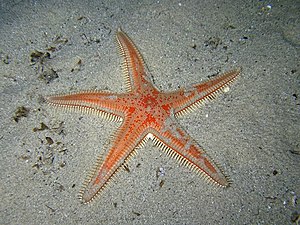Big comb star
| Red comb star | ||||||||||||
|---|---|---|---|---|---|---|---|---|---|---|---|---|

Astropecten aranciacus , Sardinia |
||||||||||||
| Systematics | ||||||||||||
|
||||||||||||
| Scientific name | ||||||||||||
| Astropecten aranciacus | ||||||||||||
| ( Linnaeus , 1758) |
The great comb star or red comb starfish ( Astropecten aranciacus ) is a kind of comb stars from the order of the Paxillensterne (Paxillosida), which is common on sedimentary soils in the Mediterranean Sea. With a height of up to 55 cm, it is one of the largest starfish .
features
The large comb star has the regular, flattened shape typical for comb stars with five triangular arms adjoining each other at clear angles and reaches a diameter of about 30 cm, sometimes up to 55 cm, which makes it the largest type of comb star in the Mediterranean. Its upper side is colored lively orange-red, whereby the overall impression comes about through differently colored, partly orange-red, partly gray to beige-colored paxilles (umbrella-like plates). The bright, pigment-poor underside of the starfish is particularly sensitive to too much light.
The starfish has superomarginal plates with 1 to 3 small thorns and inferomarginal plates with long, pointed, strong, regularly arranged thorns. The inferomarginal thorns are reddish-orange at the base and yellowish to white at the tip. The superomarginal plates are mostly homogeneous gray or beige.
Reproduction
The Großer Kammstern reproduces exclusively sexually. Like most starfish, it is segregated. There is no external difference between males and females. The eggs are fertilized externally and develop into free-swimming larvae .
Occurrence
The Great Kammstern occurs in the Mediterranean and Eastern Atlantic on sandy and muddy soils and in seagrass meadows near the coast at depths of around 5 m to 180 m.
Lifestyle and diet
Astropecten aranciacus is usually buried in the sediment at low tide and sunshine, so that only a hump protrudes in the middle of the animal. At night and at high tide, the animal becomes active and hunts prey for sea urchins , starfish , mussels and snails . The prey is swallowed whole, often in large numbers, so that the center of the body arches up, and digested in the stomach. Indigestible remains such as sea urchin and mussel shells are released back out through the mouth opening.
The preferred prey animals of adult large comb stars on the Costa Colostrai in Sardinia include heart hedgehogs ( Echinocardium mediterraneum ) and mussels ( Acanthocardia tuberculata , Chamelea gallina , Donax venustus ). According to observations by Ribi, Schärer and Ochsner (1977), Astropecten aranciacus feeds mainly on the same species as its smaller relative Astropecten bispinosus , but generally on larger individuals and also on Astropecten bispinosus itself, but not on the snail Cylichna cylindracea . Otto Hamann (1885) found the remains of more than 20 molluscs in the stomach of a large Astropecten aranciacus : 10 scallops ( Pecten sp.), 6 telltale mussels ( Tellina sp.), Some Mediterranean cone snails ( Conus mediterraneus ) and 5 barnacles ( Dentalium sp.).
literature
- Rolf Sauermost, Doris Freudig: Comb Starfish (Astropecten) . In: Lexicon of Biology . Volume 7: H to Chapter Date . 15 volumes, Elsevier, Spektrum Akademischer Verlag, Heidelberg 2006, ISBN 3-8274-0332-4 , total work: ISBN 978-3-8274-1736-7 .
- Carlos Renato R. Ventura: Astropecten . In: John M. Lawrence (Ed.): Starfish - Biology and Ecology of the Asteroidea . Johns Hopkins University Press. Baltimore 2013. pp. 101-108.
- Georg Karl Ribi, Rolf Schärer, P. Ochsner (1977): Stomach contents and size-frequency distributions of two coexisting sea star species, Astropecten aranciacus and A. bispinosus, with reference to competition . Marine Biology 43 (2), pp. 181-185.
- Georg Karl Ribi: Influence of two starfish species of the genus Astropecten on populations of their prey animals . Dissertation, University of Zurich 1978, 71 pages, OCLC 251694643 .
- Otto Hamann: Contributions to the histology of the echinoderms . Book 2, the asterids anatomically and histologically examined . Gustav Fischer Verlag, Jena 1885.
- Georgina Jones: A field guide to the marine animals of the Cape Peninsula . SURG, Cape Town 2008. ISBN 978-0-620-41639-9 .
- Réné Koehler (1921): Faune de France. Echinodermes .
- Enrico Tortonese (1965): Fauna d'Italia. Echinodermata .
- Roberto Pillon (2009): Astropecten of the Mediterranean Sea .
